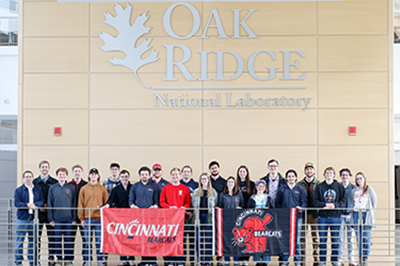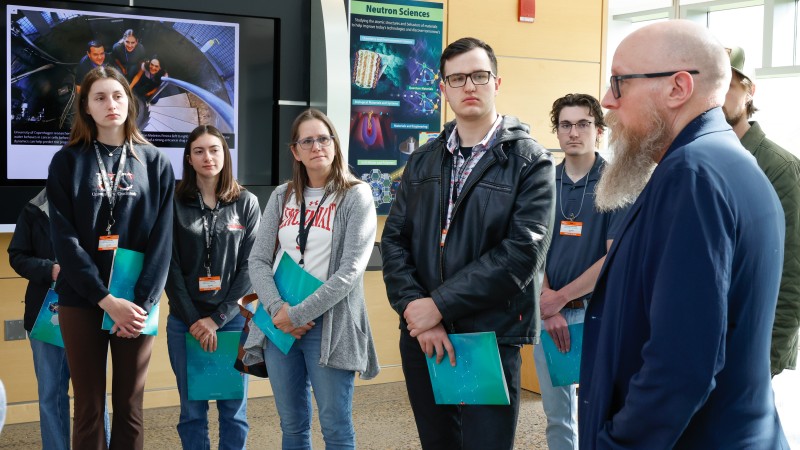A few dozen University of Cincinnati undergraduate students had the opportunity to experience “Big Science, Big Impact” in person at the Spallation Neutron Source (SNS) and High Flux Isotope Reactor (HFIR) at the U.S. Department of Energy’s Oak Ridge National Laboratory.
HFIR, which is celebrating 60 years of safe operations and scientific achievements this August, and SNS, which will turn 20 next year, offer world-class neutron scattering power and capabilities, coupled with close access to other leading research facilities at ORNL. Thousands from around the world apply each year to conduct research at HFIR and SNS, with the most promising proposals chosen by a scientific panel through peer review. Scientists whose proposals are selected use the facilities and instruments free of charge in return for making their data and findings public.
Bailey Freeland, a chemical engineering major at the University of Cincinnati, reads information about one of the Spallation Neutron instruments on a tour on Friday, April 11, 2025.
(Photo Credit: Carol Morgan/ORNL, U.S. Dept. of Energy)
Jonathan Nickels, an associate professor in the Department of Chemical and Environmental Engineering at the University of Cincinnati, worked as a postdoc in ORNL’s Neutron Sciences Directorate, leaving in 2017. The trip to ORNL was part of a university course focused on evaluating “Big Science,” which included exploring not only the impressive buildings and instruments but, perhaps most importantly, the people who make it all happen, he explained.
Student Aidan Kniskern, a math major, said he’s interested in data science and the trip opened his eyes to the many careers available at ORNL. “It interests me to see what I can do with my major and my path forward.”
Bailey Freeland, a chemical engineering major, said the university setting provides a lot of industry focus. Visiting ORNL shows many other post-academia options besides industry and manufacturing, she said, adding, “It would be really cool to get a PhD and do research here.”
Another student, Zachary Blakenship, echoed the sentiment most of the students expressed, calling the tour of the SNS instrument hall and the facility fascinating.
“I think it’s a little overwhelming, but it’s very cool to see the scale,” said Alek Vizmeg, a senior and chemical engineering major.
In fact, Neutron Scattering Division Director Jon Taylor, who gave an introduction and one of two SNS tours, discussed the scale of research when Nickels asked him to explain the concept and value of “Big Science".
“It’s a big deal, Big Science,” said Taylor. He told the undergraduates, mostly seniors, that scientific research and scattering can be done on a smaller scale, at universities and smaller settings, for example, but SNS and HFIR are massive and complex and can do so much more “for the betterment of society.”
ORNL scientist Victor Fanelli also provided a tour of SNS in the morning and the students toured HFIR in the afternoon, led by Jake Sparks, leader of the Reactor Fuel and Fabrication group.

A group photo of University of Cincinnati students who had the opportunity to tour the Spallation Neutron Source and High Flux Isotope Reactor on Friday, April 11, 2025.
(Photo Credit: Carol Morgan/ORNL, U.S. Dept. of Energy

ORNL scientist Victor Fanelli gives University of Cincinnati students a tour of the Spallation Neutron Source on Friday, April 11, 2025.
(Photo Credit: Carol Morgan/ORNL, U.S. Dept. of Energy
Why neutron scattering?
Scientists can learn information from neutron scattering that can be obtained no other way because of neutrons’ unique capabilities. Neutrons are nondestructive and highly penetrating, making it possible to study polymers, proteins, and other materials in real time and in real-world environments without destroying them. Neutrons are also sensitive to light elements like hydrogen and lithium, enabling a more accurate determination of molecular structure, important for example, in applications like locating moisture in jet fighter wings that can lead to corrosion and cracking to development of new therapeutic drugs.
Neutron scattering provides information about the positions, motions, and magnetic properties of materials. When a beam of neutrons is aimed at a sample, many neutrons pass through the material, but some interact directly with atomic nuclei and “bounce” away at an angle, like colliding balls in a game of pool. This behavior is called neutron scattering.
Using special detectors, scientists count scattered neutrons, measure their energies and the angles at which they scatter, and map their final position. This makes it possible for them to glean details about the nature of materials ranging from liquid crystals to superconducting ceramics, from proteins to plastics, and from metals to metallic glass magnets. Neutron science crosses many disciplines, from biology to chemistry to quantum.
The ORNL Neutron Nexus and outreach efforts.
ORNL launched the ORNL Neutron Nexus last year. The first program of its kind nationwide, the Neutron Nexus is a partnership with Florida Agricultural & Mechanical University and Florida State University through the FAMU-FSU College of Engineering. The program aims to broaden the scientific user community through increased outreach to universities and colleges that grows collaboration and scientific advancement.

As part of the Nexus, ORNL recently visited Duke University and is planning a trip to MIT in the early fall. The educational and outreach activities get students, faculty and scientists excited about the valuable scientific insight neutron scattering can provide that no other research method can. The Nexus also will encourage undergraduate students to apply for internship opportunities for neutron scattering and related topics at ORNL.
ORNL recently launched a New User Beamtime (NUBe) program and a new Neutron Ambassador Program, and this month named its first group of ambassadors: Boris Khaykovich, research scientist, MIT; Nayomi Plaza, materials research engineer, US Forest Service; Aashish Sapkota, staff scientist, Ames National Laboratory/Iowa State University; and Rex Hjelm, researcher, New Mexico Consortium.
Neutron ambassadors are experienced users who want to become strong advocates of neutron scattering and mentor new users in their region and/or scientific community. Ambassadors will communicate the benefits of using neutron scattering to solve complex research problems, help new users bridge any knowledge gaps as they become familiar with neutron scattering techniques, and provide encouragement to help them feel welcome in the community.
For more on the Nexus, click here. For more on the Neutron Sciences Directorate at ORNL, click here.
Media Contact
Amy J. Keller, Communications Coordinator, Neutron Sciences Directorate, Oak Ridge National Laboratory




